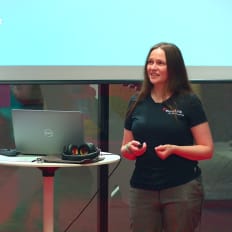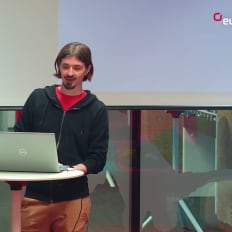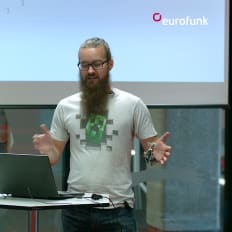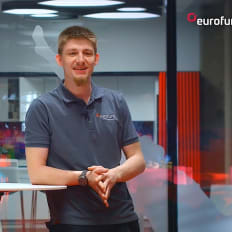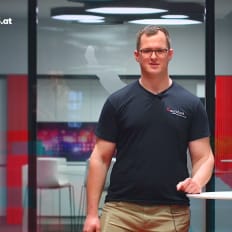
eurofunk Kappacher GmbH
Thomas Ronacher, Head of Technical Support bei eurofunk Kappacher
Description
Thomas Ronacher von eurofunk Kappacher spricht im Interview über die Struktur des Teams, die verwendeten Technologien und wie der Bewerbungs- und Onboardingprozess abläuft.
By playing the video, you agree to data transfer to YouTube and acknowledge the privacy policy.
Video Summary
In “Thomas Ronacher, Head of Technical Support bei eurofunk Kappacher,” Speaker: Thomas Ronacher outlines an ITIL-aligned support setup with Service Desk, Incident, Problem, and Monitoring & Operations teams, plus a dedicated Customer Relationship function and 24/7 Field Service; issues are handled primarily remotely and increasingly proactively in live, redundant systems. He details a mutual recruiting and onboarding process starting with an interview (HR and department lead) followed by a meet-the-team day to assess fit, with direct feedback from both candidates and teams. The team uses tools like CheckMK, Atlassian-based documentation, and a CMDB, with a goal to unify ticketing—useful context for candidates evaluating culture, collaboration, and the technical environment.
Proactive ITIL Support at eurofunk Kappacher: How Thomas Ronacher scales four teams—from Service Desk to Monitoring & Operations
The session in one line: structure, clarity, and proactive excellence
In “Title: Thomas Ronacher, Head of Technical Support bei eurofunk Kappacher,” Speaker: Thomas Ronacher from Company: eurofunk Kappacher GmbH offers a refreshingly concrete view of modern technical support. From our DevJobs.at vantage point, support here isn’t a reactive fire brigade—it’s a disciplined, continuously improving operation anchored in ITIL, close to customers, and increasingly focused on proactive work.
Ronacher describes an organization that sees, prioritizes, and fixes issues in real time—often before customers even notice. Team topology, clear responsibilities, robust processes, and pragmatic tools all play together. On top, recruiting and onboarding are explicitly mutual: a conversation-first approach followed by a team “Kennenlern-Tag” designed to make team dynamics a real decision criterion.
“Störungsbehebung ist eigentlich mittlerweile eine Operation am offenen Herzen.”
That metaphor—fixing issues as “open-heart surgery”—captures the core shift: interventions take place in live, redundant systems, with customers ideally unaware thanks to well-engineered redundancy and mindful change management.
Service organization and the role of Technical Support
Ronacher situates Technical Support within a broader Service area that includes three departments. Technical Support itself is organized into four teams closely aligned with ITIL. The result is clarity end to end—from intake to sustainable resolution:
- Service Desk as the first point of contact for incidents, customer calls, and escalations.
- Incident Team for classical incident resolution.
- Problem Team for larger incidents, problems, and software bugs—with a management dimension: prioritization, deciding what gets fixed when, and steering rollouts to customers.
- Monitoring & Operations Team to monitor customer systems in real time and drive proactive remediation—ideally “without the customer noticing.” According to Ronacher, this team is becoming more and more important.
Two additional pillars strengthen the setup:
- Customer Relationship: proactively checking in with customers—even without active issues—to assess satisfaction and collect improvement ideas.
- Field Service: ensuring 24/7 hardware support on-site, while Technical Support itself resolves issues remotely.
This design blends customer closeness, proactive risk management, and scale—an operating model that can keep up as systems grow more complex.
The four ITIL-aligned teams—how the gears mesh
1) Service Desk: the door to the system
The Service Desk is the “first touchpoint.” It channels incidents, calls, and escalations, triages what’s happening, and activates the right flow. In practice: fast intake, clean categorization, reliable handoffs, and consistent communication.
Crucially, this desk is not a black box; it’s part of a consciously designed end-to-end process. Its tight coupling with the Incident and Problem teams ensures cases don’t vanish into silos.
2) Incident Team: swift restoration with control
The Incident Team delivers the “classical” incident fix: restore normal service quickly and safely. The session makes clear that this work increasingly happens in live, redundant environments. Redundancy enables interventions with minimal user impact—but it also calls for technical precision, calm under pressure, and disciplined processes.
3) Problem Team: root causes, priorities, rollouts
Bigger incidents, persistent problems, and software bugs are owned by the Problem Team. As Ronacher notes, the work takes on “more of a management character”: setting priorities, deciding “what must be fixed when,” and coordinating rollouts to customers. In short, the team bridges deep technical understanding with change stewardship aligned to impact and risk.
Given the rising blast radius in centralized architectures, this management layer is essential for sustained service quality.
4) Monitoring & Operations: from reactive to proactive
The Monitoring & Operations Team monitors systems in real time and explicitly “leans into proactive remediation.” The goal: detect and fix issues “without the customer noticing.” That’s a clear operational thesis—interpret signals early, automate where possible, intervene with minimal footprint, and make changes invisible to end users.
The fact that this team is “becoming more important” underlines a structural shift: from reaction to stabilization, with monitoring as the steering console.
Customer Relationship and Field Service: two vital extensions
Customer Relationship: listening, even when nothing breaks
A dedicated department looks after Customer Relationship: proactively asking customers how satisfied they are and what they’d like to improve—“even if there are no issues.” This decouples feedback from emergencies and elevates the view to the whole system: expectations, usage, friction points, and opportunities.
For support teams, this is high-value input. It sharpens priorities in problem management and builds trust, because dialogue doesn’t only happen in escalation moments.
Field Service and remote-first Technical Support
Technical Support works “exclusively remote,” which speaks to efficiency and focus. If something has to be physically “taken apart,” the Field Service steps in to guarantee “24-7 hardware support.” It’s a pragmatic division of labor: remote diagnosis and resolution wherever possible; on-site capability when the job is physical.
For engineers, that’s an attractive operations environment: deep dives into systems, interpreting data and signals, planning interventions precisely—backed by a capable field team when hands-on work is required.
The big shift: proactive support and “open-heart surgery” in production
Ronacher is very clear about how technical support has changed:
- Away from a “strongly reactive approach” toward proactive monitoring and remediation.
- Focus on availability and SLAs.
- Redundant and geo-redundant systems as a working assumption.
“Incident resolution is now essentially an operation on the open heart … you’re fixing things in the live production system.”
Customers typically “don’t notice” because redundancy carries them through. Still, the challenge is fundamentally different than repairing a fully broken system. It demands mature processes, technical excellence, and steady hands.
Centralization changes impact—and the organization
Ronacher points to the recent evolution of infrastructure—“cloud technology, Kubernetes, clusters, and centralized solutions”—and its consequences. Decentralized components failing used to be more contained. In centralized setups, “a much larger user base may be affected.”
Support must therefore think in impact, prioritization, rollouts, and change control. That’s exactly where the Problem Team’s management layer comes into play, ensuring responsible decisions across wider blast radii.
Tooling, data, and transparency: CheckMK, tickets, documentation, CMDB
The tool stack is pragmatic and scales with complexity—“tool support grows with complexity”:
- CheckMK as the standard monitoring tool, enabling extensive monitoring capabilities.
- Ticket systems: there are “several” in use today—Development and Support currently use different systems. The “mid-term goal” is to unify them “for efficiency.”
- Atlassian tools to power a “good documentation database.”
- CMDB: live inventory and status for customer systems, including license and certificate validity.
For engineers, this signals data-driven operations and explicit knowledge management: metrics, tickets, documentation, and configuration data feed one another, enabling traceable flows from detection to durable resolution.
Collaboration, handoffs, and prioritization: how work actually moves
The structure suggests a collaborative flow:
- Service Desk drives clean intake and routing.
- Incident Team restores service—fast, but controlled.
- Problem Team shifts focus to causes, priorities, and rollouts—including steering decisions about “what must be fixed when.”
- Monitoring & Operations keeps the sensors sharp and acts proactively, ideally before customers feel a thing.
Together this creates a system that doesn’t leave availability to chance. ITIL is the shared framework—teams are “strongly aligned to ITIL”—providing common language, roles, and repeatable processes.
Recruiting and onboarding: mutual, team-centered, transparent
Ronacher frames recruiting and onboarding as a “mutual process.” The steps are deliberately designed:
First conversation: align on the basics and the work
After an application, there is “usually” an initial interview as the first touchpoint. Participants are “mostly a colleague from HR” and the department lead. The conversation covers:
- Modalities and working hours
- A realistic look at “what work in our department actually looks like”
The goal is mutual fit: can the candidate imagine the role, and does the team see a fit?
Kennenlern-Tag: real team experience instead of glossy slides
If both sides see potential, there is “usually” a Kennenlern-Tag (meet-the-team day). Purpose: “the team gets to know potential new colleagues, and they get to know the team.” It’s a day to observe ways of working, team composition, and collaboration patterns.
This day explicitly supports the decision—also for candidates: if someone doesn’t see themselves in the role, they can say so. For eurofunk Kappacher, it’s equally valuable to see “how the person integrates into the team.”
Transparency matters here: “you already know beforehand which team” the person would join. Afterwards, both candidates and the team provide “direct feedback”—a short, honest loop that “works quite well” in most cases.
Why this environment stands out for tech talent
From our perspective, this setup appeals strongly to engineers who want to make a real operational impact in complex systems:
- Proactive operations: real-time monitoring and surgical changes in redundant production environments.
- Clear team topology: Service Desk, Incident, Problem, Monitoring & Operations—everyone knows their lever and their handoffs.
- ITIL as shared foundation: a familiar framework for language, roles, and process.
- Customer Relationship as a feedback loop: structured input even without incidents, which helps align solutions with actual needs.
- Remote-first Technical Support with a strong Field Service complement—efficient and focused, with a clear on-site interface.
- Pragmatic tooling: CheckMK, Atlassian-backed documentation, CMDB, and ticket systems that are slated for unification.
- Transparent hiring: early clarity on team assignment, genuine meet-the-team time, and mutual decision-making.
It’s a cohesive picture of a support organization that values outcomes without losing sight of people.
What day-to-day expectations look like
The session makes it clear what mindsets matter in practice:
- Risk awareness: interventions in production call for focus and disciplined processes.
- Anticipation: proactive monitoring is about reading signals and acting at the right moment.
- Prioritization: problem management is the craft of deciding what to fix when, with an eye on impact and rollout readiness.
- Team fit: the Kennenlern-Tag exists for a reason—how someone integrates into the team is central.
- Customer empathy: not just reacting, but understanding—via Service Desk interactions, Customer Relationship conversations, and transparent communication.
These aren’t abstractions; they show up in tools, meetings, and everyday decisions.
Why unifying ticket systems matters
Development and Support currently use different ticket systems. Ronacher calls unification a mid-term goal “for efficiency.” In practice, common ticketing foundations, shared status definitions, and aligned SLAs reduce friction—especially at handoffs between Development, Problem Management, and Incident Response.
Integrations with CMDB and Monitoring add crucial context: which components are affected, the state of licenses and certificates, and more. That shortens time to diagnosis and yields more reliable rollouts—exactly the effects Ronacher’s teams need every day.
Centralized vs. decentralized architectures: thinking in blast radius
The note on centralization is key. As systems centralize, the blast radius of a single fault grows—“a much larger user base may be affected.” The support takeaway:
- Stricter change controls before rollouts.
- Layered prioritization in problem management.
- Rollback strategies and a high testing bar when changes touch large user groups.
This explains why Monitoring & Operations is gaining weight: early detection and minimal, targeted interventions are the best protection against large-scale impact.
Quotes to remember
“The teams are strongly aligned to ITIL—the framework we use to resolve incidents.”
“The Service Desk is the first touchpoint with incidents from customer systems …”
“The Problem Team has more of a management character … which errors take priority, when must things be fixed … rollouts to customers.”
“Monitoring & Operations goes strongly in the direction of proactive remediation—and remediation without the customer noticing.”
“Incident resolution is like an operation on the open heart.”
These lines crystallize the operating model: ITIL-minded, customer-centered, proactive, and responsible.
Key takeaways for engineers
- eurofunk Kappacher GmbH structures Technical Support along clear ITIL roles with four focused teams.
- Proactive monitoring and working in live, redundant production are the norm—customers ideally don’t notice.
- Customer Relationship and Field Service complement remote-first Technical Support into a full service stack.
- Tooling is solid (CheckMK, Atlassian, CMDB, ticketing) and on a path to consolidation for efficiency.
- Hiring is transparent and mutual: HR and department-lead interview, then a team “Kennenlern-Tag” with direct feedback.
Closing: a home for people who want impact—and own it
“Title: Thomas Ronacher, Head of Technical Support bei eurofunk Kappacher” showcases a support organization built on maturity, clarity, and customer closeness. For engineers who enjoy live operations, careful prioritization, and structured teamwork, it’s a compelling environment. The combination of ITIL-aligned teams, proactive monitoring, deliberate customer engagement, and a fair, mutual hiring process makes eurofunk Kappacher GmbH a place where technical excellence and team culture reinforce each other rather than compete.
More Tech Talks
eurofunk Kappacher GmbH From Sound to Sense
Sabine Hasenleithner von eurofunk Kappacher spricht in ihrem devjobs.at TechTalk über die technischen Hintergründe von Sprach Erkennung im Notruf Kontext und zeigt in einer Live Demo eine mögliche Implementierung.
Watch noweurofunk Kappacher GmbH Effortless Versioning
Stefan Höller von eurofunk Kappacher zeigt in seinem devjobs.at TechTalk, wie das Unternehmen die Versionsverwaltung bei langen Produktzyklen mithilfe von Semantic Release gestaltet hat.
Watch noweurofunk Kappacher GmbH Cypress Component Tests
Patrick Pichler von eurofunk Kappacher demonstriert in seinem devjobs.at TechTalk die Herangehensweise des Teams, wie sie Component Tests mit cypress durchführen.
Watch noweurofunk Kappacher GmbH Application Load Testing with k6
Daniel Knittl-Frank von eurofunk Kappacher spricht in seinem devjobs.at TechTalk darüber, wie die hohen Performance Anforderungen der im Unternehmen entwickelten Software erfüllt werden.
Watch now
More Tech Lead Stories
More Dev Stories
eurofunk Kappacher GmbH Viktoria Haselsteiner, Scrum Master bei eurofunk Kappacher
Viktoria Haselsteiner von eurofunk Kappacher spricht im Interview über ihren Einstieg in die Welt von Scrum, welche Fähigkeiten sie dabei als besonders hilfreich erlebt hat und worauf es ihrer Meinung nach in der täglichen Arbeit wirklich ankommt.
Watch noweurofunk Kappacher GmbH Maximilian Spiesmaier, IT Security Consultant bei eurofunk Kappacher
Maximilian Spiesmaier von eurofunk Kappacher teilt im Interview seine Erfahrungen aus der IT Security, welche Herausforderungen er im Arbeitsalltag meistert und wie man am besten in den Beruf startet.
Watch noweurofunk Kappacher GmbH Valentin Zintl, Junior Development Engineer bei eurofunk Kappacher
Valentin Zintl von eurofunk Kappacher erzählt im Interview über seinen Karriereweg, welche Aufgaben ihn täglich erwarten und welche Fähigkeiten besonders für den Einstieg wichtig sind.
Watch noweurofunk Kappacher GmbH Johannes Festi, Trainee Software Development bei eurofunk Kappacher
Johannes Festi von eurofunk Kappacher gibt im Interview Einblicke in den Arbeitsalltag als Software Development Trainee, wie er dazu gekommen ist und was seiner Ansicht nach wichtig für den Einstieg ist.
Watch now

